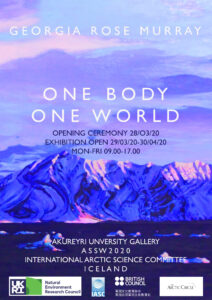Painter and researcher Georgia Rose Murray reflects on creating deep connections to landscapes through her artwork, whether inspired by the extreme wilderness of the Arctic or lockdown in the Scottish Highlands.
Degree: Master of Fine Arts (MFA) in Contemporary Art Practice, 2013
Current treasured object: My bikini. I start each day by running through the woods to the River Spey. I take a small towel, leave my running things on the river bank, swim and then run home for breakfast.
Song of the moment: ‘Like Water’ by Christian Löffler (feat. Mohna)
The first thing I noticed when I woke up this morning: The beautiful sunrise colours in the sky – let’s get to the edge – to see the horizon, feel the space and swim in the North Sea.
When I returned from a research expedition to Arctic Svalbard in mid-March 2020, the space provided by lockdown in Scotland felt like a gift.
Suddenly I wasn’t able to travel a weekly 200-mile round trip between home in the Highlands and Dundee, where I used to work in my Wasps Studio and at Duncan of Jordanstone College of Art & Design. I had a lot of time to process the incredibly magical month which I had just experienced – observing and responding to the return of light in Ny-Ålesund, the most northern research station on Earth.
Each time I spend time working in the landscape during a different Arctic season, I learn new processes and techniques to enable me to create paintings, films and photographs amid extreme weather conditions.

Earlier in 2020, when the average air temperature was -30°C in Ny-Ålesund, I discovered that mixing 96% scientific ethanol with pigment, ink and watercolour paint, was a brilliant substitute to water, as it remained in its liquid state for much longer. I would also take flasks of hot water with me whilst painting outside and mix the two mediums to create a viscous substance which took a long time to dry.
In 2018 I used an analogue camera to take low light photographs of the sun setting and the camera could withstand the average temperature of -7°C, as long as it was protected by a woolly hat and kept away from the wind when it wasn’t being used. This year, the old Pentax which I took north was unable to function well in the much cooler air. About one photograph was possible before the shutter froze and needed to be thawed out somewhere warm before taking the next photograph.
Using a camera, tripod and drawing and painting outside in -30°C air had a lasting effect on my extremities and the frostbitten nerves in my fingers and toes will continue growing back at approximately 1mm per month. A minimal amount of physical suffering in return for a once in a life-time opportunity to spiritually absorb and visually respond to Arctic sunrise during this poignant period of change.
Walking fast, to warm up, with top and bottom eyelashes sticking together, freezing thighs and hands and with glowing pink cheeks and nose, I returned to the Czech station for breakfast, after documenting the morning performance of colours in the sky. [Extract from my Arctic diary, 19 February 2020]

Living remotely from the environment which feels most natural to me has taught me to connect deeply, through the work I make. In my studio, I respond to landscapes, by using painting and film-mediums to expressively translate holistic experiences. Whilst engaged in the making process, I am transported to the moment when the initial inspiration was born.
Creating film works and projecting them over or beside paintings is absorbing and immersive in thrilling ways – the connections captured in the moment by digital camera and the marks I make with brushes and paint link the landscape and my studio environment and span time.

It has been sad to not be able to share my newest work with gallery audiences. My latest solo exhibition, ‘One Body One World’, was due to open in Iceland in March, however this was unfortunately cancelled due to Covid travel restrictions.

Making regular expeditions to Arctic and Antarctic environments and touching base with the incredible space, clear air and magical natural light and darkness towards the poles is something which I endeavour to do when ever research money and time allow it.
Absorbing the reality and learning about the natural processes which occur in the wilderness, then responding with visual mediums is ultimately inspiring to me. During the recent uncertain times most polar travel has been restricted and a lot of crucial funding has been taken away. Now, my ability to make plans to journey north and south and physically connect with these places, is in question.
Intermittently traveling on foot and mountain bike from home, where I paint and write, to wild places where I draw and swim, is generally how my day is structured. I go outside several times a day, exercising and responding to light and colour with pens and watercolour, and I write and read whilst at home.
With a range of seasonal experiences of the Arctic Tundra it has been fascinating to draw comparisons with the geology, flora and fauna which I have been lucky to witness close to home, in the Scottish Cairngorm mountains, over the last several months during lockdown. Seeing the same species in Scotland and in the Arctic, for example Purple Saxifrage in the summer and Ptarmigan at the tops of snowy mountains in winter, is always lovely. For many years I have seen Scotland as a neutral secure base, from which to come and go and respond to disparate places through the work I make. Now, it feels to be more than a base and I am drawn to making deeper research links to the landscape I am surrounded by daily.
(Lead photo: Georgia Rose Murray in Arctic Svalbard.)



